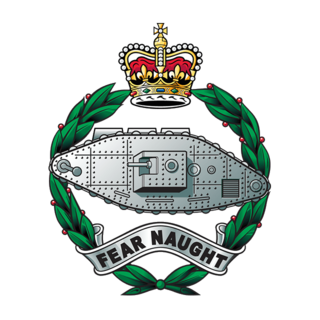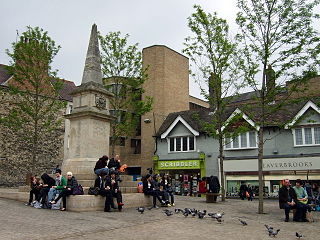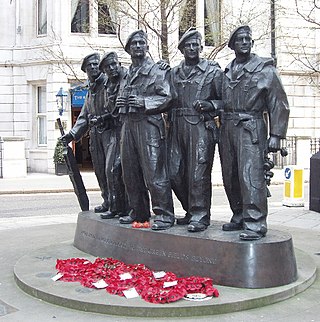
The Royal Tank Regiment (RTR) is the oldest tank unit in the world, being formed by the British Army in 1916 during the First World War. Today, it is the armoured regiment of the British Army's 12th Armoured Infantry Brigade. Formerly known as the Tank Corps and the Royal Tank Corps, it is part of the Royal Armoured Corps.

The Royal Wessex Yeomanry is a reserve armoured regiment of the British Army Reserve consisting of five squadrons. Formerly part of 43 (Wessex) Brigade, the regiment joined 3rd (UK) Division in July 2014, to provide armoured resilience to the three armoured regiments within the Reaction Force. In 2015 the regiment was moved from the operational command of 3rd (UK) Division to 1st Armoured Infantry Brigade, and later to 12th Armoured Brigade Combat Team, but members of the regiment still wear the 3rd (UK) Division formation badge to reflect their role in supporting the three armoured regiments in the division.

The Tank Museum is a collection of armoured fighting vehicles at Bovington Camp in Dorset, South West England. It is about 1 mile (1.6 km) north of the village of Wool and 12 miles (19 km) west of the major port of Poole. The collection traces the history of the tank. With almost 300 vehicles on exhibition from 26 countries it is the largest collection of tanks and the third largest collection of armoured vehicles in the world. It includes Tiger 131, the only working example of a German Tiger I tank, and a British First World War Mark I, the world's oldest surviving combat tank. It is the museum of the Royal Tank Regiment and the Royal Armoured Corps and is a registered charity.

The 1st Royal Tank Regiment was an armoured regiment of the British Army. It is part of the Royal Tank Regiment, itself part of the Royal Armoured Corps and operationally under 12th Armoured Infantry Brigade.
The 45th Royal Tank Regiment was an armoured regiment of the British Territorial Army that fought at the Battle of Alamein during World War II and continued to serve during the 1950s.
The 51st Royal Tank Regiment was an armoured regiment of the British Territorial Army that fought in the Tunisian and Italian campaigns during World War II and continued to serve during the 1950s.

The 9th Royal Tank Regiment was an armoured regiment of the British Army active during the Second World War. It was part of the Royal Tank Regiment, itself part of the Royal Armoured Corps. It was reformed in late 1940 as a hostilities-only regiment.

Sir William Goscombe John was a prolific Welsh sculptor known for his many public memorials. As a sculptor, John developed a distinctive style of his own while respecting classical traditions and forms of sculpture. He gained national attention with statues of eminent Victorians in London and Cardiff and subsequently, after both the Second Boer War and World War I, created a large number of war memorials. These included the two large group works, The Response 1914 in Newcastle upon Tyne and the Port Sunlight War Memorial which are considered the finest sculptural ensembles on any British monument.

The Tirah Memorial is a war memorial in Bonn Square, Oxford, England. It commemorates soldiers of the 2nd Battalion Oxfordshire Light Infantry who died in 1897–98 on the Tirah Expedition and Punjab Frontier Campaign to suppress rebel tribes on the North West Frontier of British India.

The Royal Air Force Memorial is a military memorial on the Victoria Embankment in central London, dedicated to the memory of the casualties of the Royal Air Force in World War I. Unveiled in 1923, it became a Grade II listed structure in 1958, and was upgraded to Grade II* in 2018. It is considered to be the official memorial of the RAF and related services.

George Henry Paulin, often called Harry Paulin, or 'GHP' was a Scottish sculptor and artist of great note in the early 20th century.

Vivien Mallock FRBS is an English sculptor who works mainly in bronze. Her career started at the Museum of Army Flying in Hampshire where she sculpted several celebrated World War II fighter pilots, including John Cunningham, to mark the 50th anniversary of the Battle of Britain. She became a member of the Armed Forces Art Society in 1992, a member of the Society of Women Artists in 1993 and an associate of the Royal British Society of Sculptors in 1998.
The Leeds Rifles was a unit of the 19th century Volunteer Force of the British Army that went on to serve under several different guises in the World Wars of the 20th century. In the First World War, both battalions served as infantry on the Western Front. They were later converted into an anti-aircraft and tank units, and fought in North Africa, Italy, and Burma during the Second World War.

The Royal Fusiliers War Memorial is a memorial in London, dedicated to the members of the Royal Fusiliers killed in the World Wars, Russian Civil War and subsequent conflicts, along with members of a number of London Regiment battalions killed in the First World War. It consists of a bronze statue on a 16.5 feet (5.0 m) pedestal made of Portland stone.

A Grade II-listed bronze statue of Robert Clive, 1st Baron Clive, by John Tweed, stands in King Charles Street, Whitehall, London. The work was unveiled in 1912 outside Gwydyr House, also in Whitehall, and was moved to its current location in 1916.

Tiger 131 is a German Tiger I heavy tank captured by the British 48th Royal Tank Regiment in Tunisia during World War II. Preserved at The Tank Museum in Bovington in Dorset, England, it is currently the only operational Tiger I in the world.

The Chindit Memorial is a war memorial in London, England, that commemorates the Chindit special forces, which served in Burma under Major General Orde Wingate in the Second World War. The memorial was erected in Victoria Embankment Gardens in 1990, near the Ministry of Defence headquarters, and also commemorates Wingate, who died on active service in Burma in 1944. It became a Grade II listed building in August 2020.

St Saviour's War Memorial is a war memorial on Borough High Street, in the former parish of Southwark St Saviour, to south of the River Thames in London. It became a Grade II listed building in 1998 and was upgraded to Grade II* in 2018.















